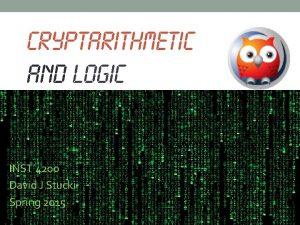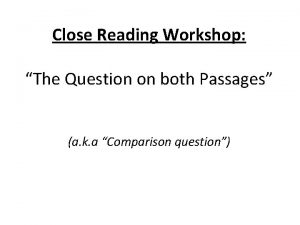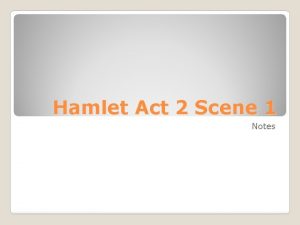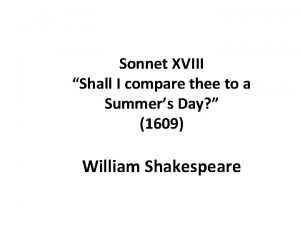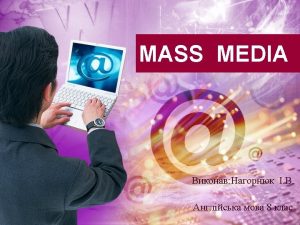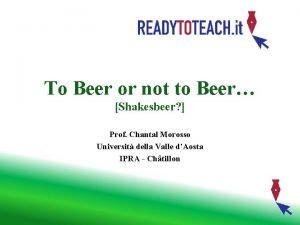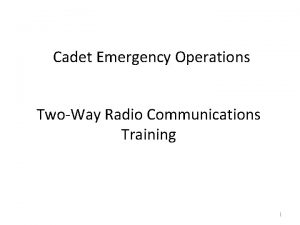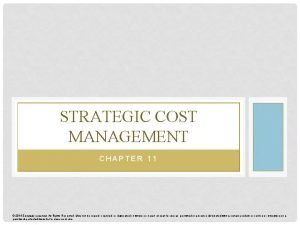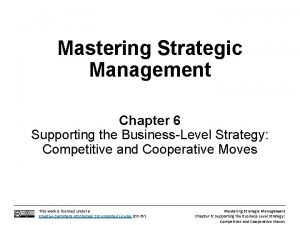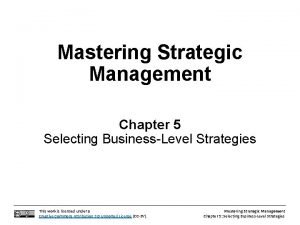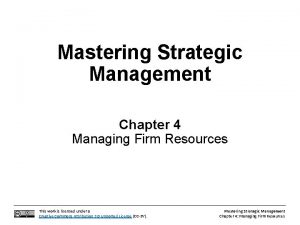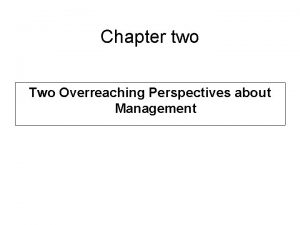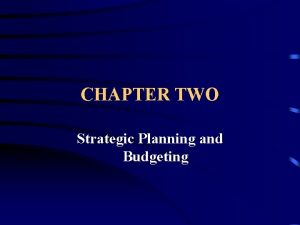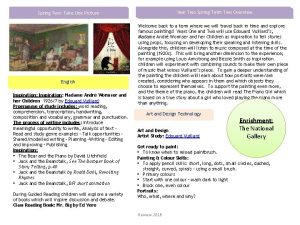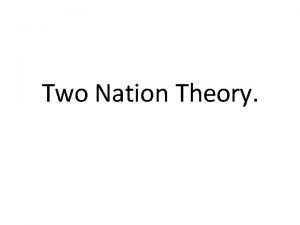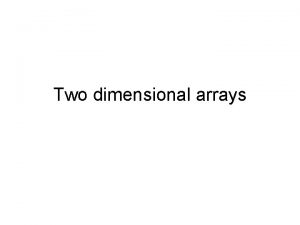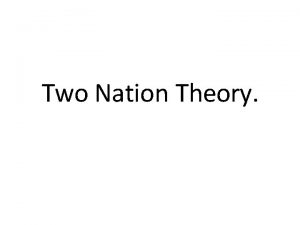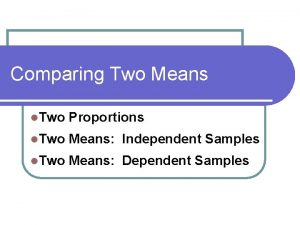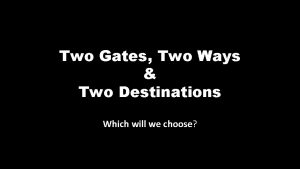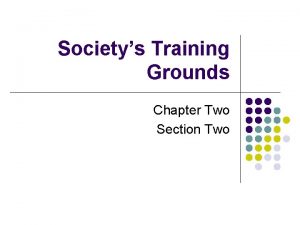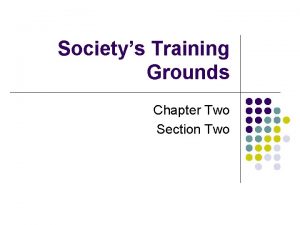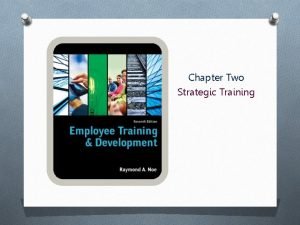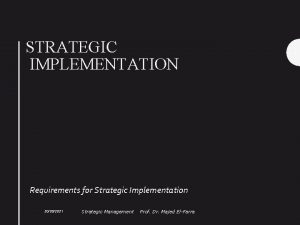Chapter Two Strategic Training Training is Strategic O

























- Slides: 25

Chapter Two Strategic Training

Training is Strategic O Training can have both a direct an indirect impact on organizational success O Business strategy will shape the training function o Strategic impacts what gets trained, who gets training, and how much training is valued O The role of training is evolving o Event to Learning Copyright © 2017 Mc. Graw-Hill Education. All rights reserved. No reproduction or distribution without the prior written consent of Mc. Graw-Hill Education.

4 Steps of Strategic Training O Identify the organization’s business strategy O Determine strategic training initiatives O Translate initiatives into concrete learning activities O Identify metrics and evaluate Copyright © 2017 Mc. Graw-Hill Education. All rights reserved. No reproduction or distribution without the prior written consent of Mc. Graw-Hill Education.

The Strategic Process Copyright © 2017 Mc. Graw-Hill Education. All rights reserved. No reproduction or distribution without the prior written consent of Mc. Graw-Hill Education.

1. Identify Business Strategy O Determine the company’s mission O Establish goals O Perform a SWOT—strengths, opportunities, weakness, and threats o Internal and external O Determine strategic choice Copyright © 2017 Mc. Graw-Hill Education. All rights reserved. No reproduction or distribution without the prior written consent of Mc. Graw-Hill Education.

Formulating Business Strategy Copyright © 2017 Mc. Graw-Hill Education. All rights reserved. No reproduction or distribution without the prior written consent of Mc. Graw-Hill Education.

Common Strategic Initiatives O Diversify the learning portfolio O Expand who is trained O Accelerate the pace of learning O Improve customer service O Capture and share knowledge O Ensure the work environment supports learning and transfer of training Copyright © 2017 Mc. Graw-Hill Education. All rights reserved. No reproduction or distribution without the prior written consent of Mc. Graw-Hill Education.

3. Translate Initiatives to Activities O The next step is to determine specific, concrete activities that align with strategic initiatives O Such activities will vary based on the initiatives that were developed Copyright © 2017 Mc. Graw-Hill Education. All rights reserved. No reproduction or distribution without the prior written consent of Mc. Graw-Hill Education.

4. Identify Metrics & Evaluate O The final step is to determine if training investments were successful O Strategic training evaluation is not intended to evaluate the effectiveness of an isolated program, but a set of training activities O The business-related outcomes examined should be directly linked to strategy and goals Copyright © 2017 Mc. Graw-Hill Education. All rights reserved. No reproduction or distribution without the prior written consent of Mc. Graw-Hill Education.

Balanced Scorecard O Customer (time, quality, performance, service, cost) O Internal business processes (processes that influence customer satisfaction) O Innovation and learning (operating efficiency, employee satisfaction, continuous improvement) O Financial (profitability, growth, shareholder value) Copyright © 2017 Mc. Graw-Hill Education. All rights reserved. No reproduction or distribution without the prior written consent of Mc. Graw-Hill Education.

Roles of Employees & Managers O Employees now performing roles once reserved for management O Given the prevalence of teams, employees require more cross-training and interpersonal skills training O Managers’ jobs are highly complex, requiring greater skill and training Copyright © 2017 Mc. Graw-Hill Education. All rights reserved. No reproduction or distribution without the prior written consent of Mc. Graw-Hill Education.

Top Management Support O Set a clear direction for learning O Provide encouragement and resources O Take an active role in governing learning O Develop and teach new programs O Serve as a role model O Promote learning through different channels Copyright © 2017 Mc. Graw-Hill Education. All rights reserved. No reproduction or distribution without the prior written consent of Mc. Graw-Hill Education.

Global Presence O For companies with global operations, training is needed to prepare employees for overseas assignments O Companies must decide if training will be coordinated through a central U. S. facility or through satellite locations o Shared resources / services or o Specific to the region / function? Copyright © 2017 Mc. Graw-Hill Education. All rights reserved. No reproduction or distribution without the prior written consent of Mc. Graw-Hill Education.

Business Conditions we have seen this before O With low unemployment, it’s difficult to find top talent O In unstable environments, training may become short-term O When there is growth, training will be in high demand Copyright © 2017 Mc. Graw-Hill Education. All rights reserved. No reproduction or distribution without the prior written consent of Mc. Graw-Hill Education.

Strategic Value & Uniqueness O Knowledge-based workers—heavy training O Job-based employees—less training than knowledge workers O Contract employees—limited training O Alliance/partnerships—sharing expertise and team training Copyright © 2017 Mc. Graw-Hill Education. All rights reserved. No reproduction or distribution without the prior written consent of Mc. Graw-Hill Education.

Extent of Unionization O Presence of a union leads to joint union- management programs for preparing employees for jobs O Given that unions have a significant impact on HRM practices, they must be involved in determining strategic training priorities O Collaboration is key Copyright © 2017 Mc. Graw-Hill Education. All rights reserved. No reproduction or distribution without the prior written consent of Mc. Graw-Hill Education.

Training in Different Strategies O External Growth Strategy o Integration, redundancy, and restructuring O Disinvestment Strategy o Efficiency Copyright © 2017 Mc. Graw-Hill Education. All rights reserved. No reproduction or distribution without the prior written consent of Mc. Graw-Hill Education.

Centralized Training O There are several advantages: o Stronger alignment with strategy o Common set of metrics or scorecards to evaluate training o Streamlined processes o Better integration of programs to develop leaders o Easier to manage talent during times of change Copyright © 2017 Mc. Graw-Hill Education. All rights reserved. No reproduction or distribution without the prior written consent of Mc. Graw-Hill Education.

Corporate University Model Copyright © 2017 Mc. Graw-Hill Education. All rights reserved. No reproduction or distribution without the prior written consent of Mc. Graw-Hill Education.

Business-Embedded Function Copyright © 2017 Mc. Graw-Hill Education. All rights reserved. No reproduction or distribution without the prior written consent of Mc. Graw-Hill Education.

A Change Model Copyright © 2017 Mc. Graw-Hill Education. All rights reserved. No reproduction or distribution without the prior written consent of Mc. Graw-Hill Education.

Marketing Training O Despite its value, some individuals may not necessarily value training O Training often needs to be marketed so key constituents value learning O Internal marketing involves making employees and managers excited about training and learning Copyright © 2017 Mc. Graw-Hill Education. All rights reserved. No reproduction or distribution without the prior written consent of Mc. Graw-Hill Education.

Internal Marketing Tactics O Involve the target audience O Demonstrate how training can solve business problems O Show examples of previous successes O Identify a “champion” who supports training O Advertise through multiple channels O Speak in terms employees understand Copyright © 2017 Mc. Graw-Hill Education. All rights reserved. No reproduction or distribution without the prior written consent of Mc. Graw-Hill Education.

Outsourcing Training O Reasons for outsourcing: o Cost savings o Time savings that allow a company to focus on business strategy o Improvements in compliance with regulatory training o Lack of internal capability to meet learning demands o Desire to access best training practices Copyright © 2017 Mc. Graw-Hill Education. All rights reserved. No reproduction or distribution without the prior written consent of Mc. Graw-Hill Education.

Be Strategic O Outsourcing may not necessarily be the solution O Be sure to consider: o the skill set in question o resources and expertise o desire for control o the quality of the potential vendor o the importance of training in the organization Copyright © 2017 Mc. Graw-Hill Education. All rights reserved. No reproduction or distribution without the prior written consent of Mc. Graw-Hill Education.
 Strategic fit vs strategic intent
Strategic fit vs strategic intent Strategic complements example
Strategic complements example Strategic competitiveness
Strategic competitiveness Cultural aspects of strategy choice
Cultural aspects of strategy choice Complementary and supplementary angles formula
Complementary and supplementary angles formula Two little feet
Two little feet Osha 29cfr1910.134
Osha 29cfr1910.134 Two two four cryptarithmetic solution
Two two four cryptarithmetic solution Identify a key term used in both passages.
Identify a key term used in both passages. Linear pair relationship
Linear pair relationship When two curves coincide the two objects have the same
When two curves coincide the two objects have the same Which two points do the two passages agree on?
Which two points do the two passages agree on? The nonadjacent angles formed by two intersecting lines
The nonadjacent angles formed by two intersecting lines Two beer or not two beer shakesbeer
Two beer or not two beer shakesbeer Hamlet act 2 scene 1 summary
Hamlet act 2 scene 1 summary Two witches were watching two watches
Two witches were watching two watches Contingency table in statistics
Contingency table in statistics Shall i compare thee to a summer's day annotation
Shall i compare thee to a summer's day annotation If two witches would watch
If two witches would watch Two beer or not two beer shakesbeer
Two beer or not two beer shakesbeer How has macbeth changed since act 1
How has macbeth changed since act 1 Two way radio communication training
Two way radio communication training Chapter 11 strategic cost management
Chapter 11 strategic cost management Mastering strategic management
Mastering strategic management Strategic management chapter 5
Strategic management chapter 5 Strategic management chapter 4
Strategic management chapter 4







